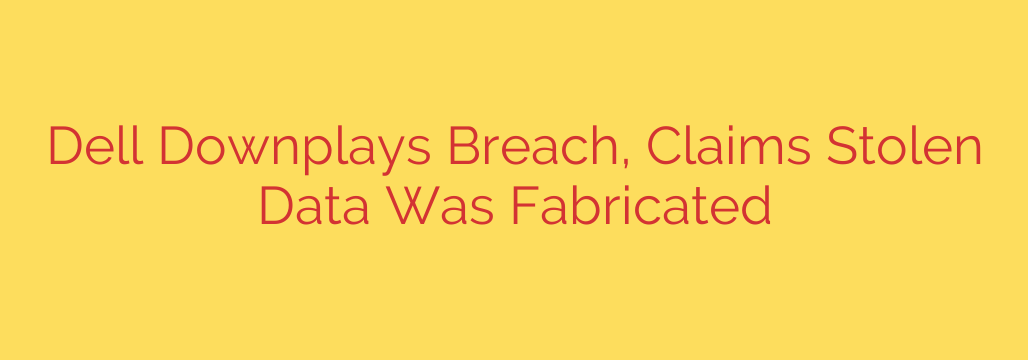
Understanding the Dell Data Breach: What Was Stolen and How to Protect Yourself
Recent reports have surfaced regarding a significant security incident involving Dell, leading to confusion and concern among customers. While initial claims by a threat actor suggested a massive theft of sensitive data, the situation requires a closer look. Here’s a clear breakdown of what happened, what information was compromised, and the essential steps you should take to secure your information.
The Incident: Conflicting Reports and Official Clarification
News of the breach first emerged when a hacker claimed to have stolen a database containing personal information for approximately 49 million Dell customers. The hacker attempted to sell this data on a dark web forum, creating widespread alarm.
Following an investigation, Dell confirmed that a security breach had indeed occurred. However, the company has stated that the scope and nature of the compromised data were misrepresented by the attacker. According to Dell, the breach involved a portal containing information related to customer purchases, but it did not include the highly sensitive data the hacker claimed to possess.
What Data Was Actually Exposed?
It’s crucial to understand precisely what information was accessed. The breach was limited to a specific type of data and, importantly, did not expose information that could lead to direct financial theft.
Information that was accessed includes:
- Customer Name
- Physical (Shipping) Address
- Dell Hardware and Order Information: This includes your device’s service tag, item description, date of order, and warranty details.
Information that was NOT accessed includes:
- Financial or payment information (e.g., credit card numbers)
- Email addresses
- Telephone numbers
While the absence of financial data is reassuring, the compromised information still poses a security risk that every Dell customer should take seriously.
The Real Risk: Sophisticated Phishing and Social Engineering
The primary danger from this breach is not that someone will steal your money directly, but that they will use the stolen information to trick you. Scammers can leverage your name, address, and specific order history to create highly convincing and targeted phishing attacks.
For example, a scammer could:
- Call or email you pretending to be from Dell support. They could reference your exact computer model, service tag, and purchase date, making their story sound completely legitimate.
- Offer a fake warranty extension or technical support. They might say, “I see your warranty for the Dell XPS 15 you purchased on [Order Date] is expiring. We can offer you a discount to renew it today.”
- Trick you into giving up more sensitive information. By establishing trust with the stolen order details, they could then ask for credit card information for a “service fee” or persuade you to install malicious software on your computer.
This is a significant threat because the scammers have specific, credible details that make their fraudulent attempts much more believable than a typical generic phishing email.
Actionable Security Tips for Dell Customers
Given the nature of the exposed data, vigilance is your best defense. Here are the steps you should take immediately to protect yourself from potential scams.
Be Extremely Skeptical of Unsolicited Contact. Treat any unexpected phone call, text, or email claiming to be from Dell with suspicion. Even if they quote your correct name, address, and order details, do not assume they are legitimate.
Never Provide Personal or Financial Information. Dell will not call you unexpectedly and ask for your credit card number, password, or bank account details. If anyone asks for this information, it is a major red flag. Hang up the phone or delete the email.
Initiate Contact Through Official Channels. If you need to contact Dell support, do not use a phone number or website link provided in an unsolicited email. Instead, go directly to the official Dell website by typing
Dell.cominto your browser and find their official support contact information there.Do Not Click on Suspicious Links or Attachments. Scammers will often include links to fake login pages or attachments containing malware. Avoid clicking on anything in an email you were not expecting.
Educate Yourself and Others. Be aware of the tactics used in social engineering and phishing attacks. The more you know about how these scams work, the easier it will be to spot them.
While this data breach did not expose financial details, the compromised information serves as a powerful tool for sophisticated criminals. By staying alert and following these security best practices, you can significantly reduce your risk of becoming a victim.
Source: https://go.theregister.com/feed/www.theregister.com/2025/07/21/dell_scoffs_at_breach/








